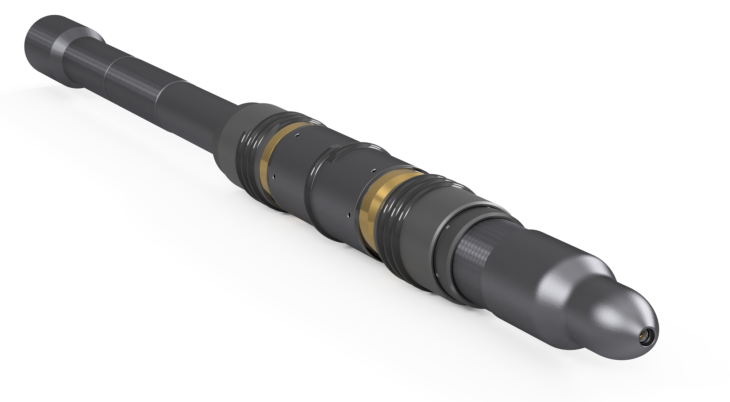The OGM Interactive Edition - Summer 2023 - Read Now!
View Past IssuesOctober 9th, 2019 – Product Guide:
A transformational tool which could significantly reduce the cost of decommissioning is being developed by Aberdeen-based oil and gas technology company Deep Casing Tools (DCT) in collaboration with the Oil and Gas Technology Centre (OGTC) and Total.
The UK is expected to spend more than £15b on oil and gas decommissioning over next decade with the global figure for the same period estimated at £84b ($105b).
Plugging and abandonment (P & A) is the complex process by which a well is closed permanently and typically accounts for about 45% of projected decommissioning costs.
Current technologies used for P & A – cut and pull; perforate and wash and, as a last resort, section milling – can create significant challenges with research revealing that around 20% of all pulling operations take longer and cost more than anticipated.
Early trials have shown that DCT’s Casing Cement Breaker™, an industry first, can make these operations more predictable and reliable and can have a major impact on the length of an operation.
“Early results show that up to 90% less force is required to pull a casing following a run with the Casing Cement Breaker™,” said David Stephenson, DCT’s chief executive.
“One company told me they are currently taking up to 70 days to cut and pull some casing in the Norwegian North Sea. It is too early to say how much we could reduce that by, although we hope it will ultimately be 90%, but even if it were only 10% that would be a huge reduction given rig rates of up to £350,000 a day.”

DCT has a long-established record in saving time and money for oil and gas companies and reducing risk by developing a range of smart, simple and proven technologies which provide a complete solution across the drilling and completion cycle.
This idea for this latest innovation came after a brainstorming session with an inventor and former colleague of David Stephenson.
“We started with some ideas, did some sketches and then built a small model tool to test the principle,” he said. “We built a load of samples, ran the tool, and even in those early workshop tests we reduced the force required to pull a piece of casing by 90% using Casing Cement Breaker.”
DCT then built a larger workshop prototype and approached the OGTC for assistance. The OGTC canvassed members and it attracted the interest of Total who offered in-kind funding and the OGTC offered cash support.
“We now have a three-way partnership with the OGTC and Total and the tool will be trialled early next year on wells in Total’s Alwyn and Franklin fields in the first quarter of next year, with the aim of it being fully commercial by the end of 2020,” said David.
“In the meantime, Equinor carried out a trial in the Huldra field, using the workshop prototype which confirmed the potential of what might be achieved. It reduced the force required to pull a piece of casing by about 40%, which would mean a 10-day job would take six days, and that tool had really only been designed for workshop testing. We have taken the learnings from that trial, looked at how we can make it even better, addressed those issues and are now building a second-generation prototype.
“Industry involvement is important to me. By partnering with the OGTC and Total through the development we know we will end up with a fit-for-purpose tool when we go to market.”
Malcolm Banks, Wells Solution Centre Manager of the OGTC, said: “Reducing well P & A costs is a key area of the OGTC Wells Roadmap. The Casing Cement Breaker has the potential to significantly reduce the time and cost of casing recovery to allow well barrier placement, so is well aligned with our strategic objectives.
“DCT has a proven track record of developing and commercialising innovative ideas for the drilling and completion industry, giving us confidence they will be able to deliver on this current project.
“The role of the OGTC is to accelerate technology development to bring value to the industry. This can only be achieved with appropriate industry collaboration, therefore the active participation of Total and Equinor in the development and field trialling of this innovative technology is vital.”
Martyn Fear, Total’s Offshore Wells Manager, said that Total in the North Sea is progressing a technology and operational programme designed to cut well plug and abandonment cost by 50%.
Similar efforts are underway to improve slot recovery options, to reduce the cost of recovering incremental reserves without investment in new facilities. As part of these goals, Total is constantly searching for relevant innovations and suitable partners.
“One such innovation is the Casing Cement Breaker which holds great promise for improving casing recovery operations,” he said. “The potential of this invention is sufficient for the OGTC to support this as relevant to the wider industry, and hence to enter into a partnership with Total, and DCT, to progress it.
“This collaboration now combines the proven capabilities of DCT in innovation, design and product development; the well engineering, test rig programmes and field trial opportunities afforded by Total; and the governmental backing provided by OGTC.
“This brings the best of the industry together, focussed on making the North Sea oil and gas industry a leader in these late life technologies.”
Did you enjoy this article?